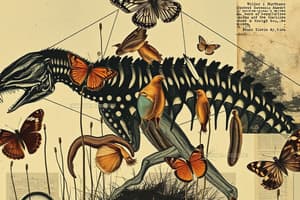Podcast
Questions and Answers
जीव प्रक्रम में क्या महत्वपूर्ण तत्व है?
जीव प्रक्रम में क्या महत्वपूर्ण तत्व है?
जीविका संकल्प
स्वभाव का क्या अर्थ है?
स्वभाव का क्या अर्थ है?
अपनी प्राकृतिक स्थिति
श्री अरविंद घोष ने किस अवधारणा को प्रस्तुत किया था?
श्री अरविंद घोष ने किस अवधारणा को प्रस्तुत किया था?
जीविका संकल्प
सेवा और तपस्या का सम्बंध किस उद्देश्य के साथ है?
सेवा और तपस्या का सम्बंध किस उद्देश्य के साथ है?
जीविका संकल्प का क्या महत्व है?
जीविका संकल्प का क्या महत्व है?
जीव प्रक्रम क्या दिखाता है?
जीव प्रक्रम क्या दिखाता है?
जीविका संकल्प कौन-कौन से आचारणों के माध्यम से आत्म-अभिवृद्धि की ओर ले जाता है?
जीविका संकल्प कौन-कौन से आचारणों के माध्यम से आत्म-अभिवृद्धि की ओर ले जाता है?
जीविका संकल्प क्या दर्शाता है?
जीविका संकल्प क्या दर्शाता है?
जीव प्रक्रम के अनुसार हर व्यक्ति की क्या विशेषता होती है?
जीव प्रक्रम के अनुसार हर व्यक्ति की क्या विशेषता होती है?
कैसे व्यक्ति अपने आंतरिक शक्ति का संरक्षण कर सकते हैं, जो परंतु परंपरागत भौतिक सीमाओं से परे होती है?
कैसे व्यक्ति अपने आंतरिक शक्ति का संरक्षण कर सकते हैं, जो परंतु परंपरागत भौतिक सीमाओं से परे होती है?
जीव प्रक्रम में जीवों को किस तरह से संगठित किया जाता है?
जीव प्रक्रम में जीवों को किस तरह से संगठित किया जाता है?
जीवों को समूहों में वर्गीकृत करने के लिए कौन-कौन से सिद्धांतों पर जीविका संकल्प आधारित है?
जीवों को समूहों में वर्गीकृत करने के लिए कौन-कौन से सिद्धांतों पर जीविका संकल्प आधारित है?
किस विभाग में जीवों को समूहों में संगठित किया जाता है?
किस विभाग में जीवों को समूहों में संगठित किया जाता है?
किस सिद्धांत पर जीवों को समूहों में वर्गीकृत किया जाता है?
किस सिद्धांत पर जीवों को समूहों में वर्गीकृत किया जाता है?
किस प्रकार के जीवों की संयुक्त जीविका संरचना के तहत जिम्मेदारी आती है?
किस प्रकार के जीवों की संयुक्त जीविका संरचना के तहत जिम्मेदारी आती है?
जीव प्रक्रम क्या प्रकट करता है?
जीव प्रक्रम क्या प्रकट करता है?
जीव प्रक्रम क्या साबित करता है?
जीव प्रक्रम क्या साबित करता है?
Flashcards are hidden until you start studying
Study Notes
Jiva Prakram is a concept related to the organization of living beings according to their similarities and differences. It forms part of a broader understanding of biological classification, which includes kingdoms, phyla, classes, orders, families, genera, species, subspecies, varieties, and formae. This system helps biologists understand how different organisms have evolved from common ancestors through descent with modification over millions of years.
The jivik structure, as proposed by Dr. Raghunandan Sharma, is based upon principles such as homology, analogy, resemblance, affinity, identity, unity, relationship, evolutionary process, genetic composition, functional characteristics, etc.. These principles help classify organisms into groups called taxa. For example, Homo sapiens, Gorilla gorilla, Pan troglodytes, Chimpanze, Hylobates lar, Macaca mulatta, Papio hamadryas, Cercopithecus aethiops, Saimiri sciureus, Callithrix jacchus, Otolemur crassicaudatus, Tarsier, Pteropus, Megabatidae, Vespertilionidae, Fledermause, Chiroptera, Monotremata, Prototheria, Marsupialia, Eutheria, Mammalia, Synapsida, Diapsida, Reptilia, Anthozoa, Coelenterate, Porifera, Platyhelminthes, Nematoda, Annelida, Arthropod, Mollusk, Echinodermata, Cnidarian, etc., all belong to the Kingdom Animalia.
Jiva prakram also incorporates other systems of classification, like those developed by Carl Linnaeus and Ernst Mayr, among others. These systems serve as a foundation for understanding various aspects of life sciences, including zoology, botany, ecology, physiology, genetics, and more.
In summary, Jiva Prakram is a comprehensive framework for classifying living things based on shared traits, providing scientists with a toolkit to categorize species accurately and efficiently, facilitating further study and discovery within fields of natural history and biological science.
Studying That Suits You
Use AI to generate personalized quizzes and flashcards to suit your learning preferences.




